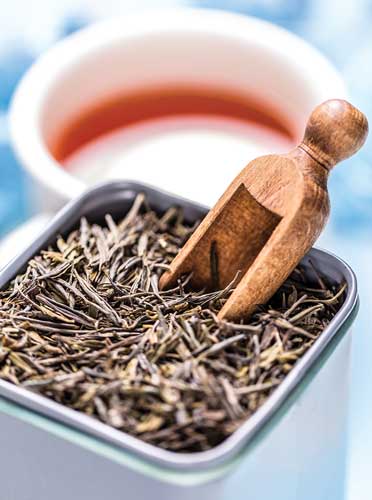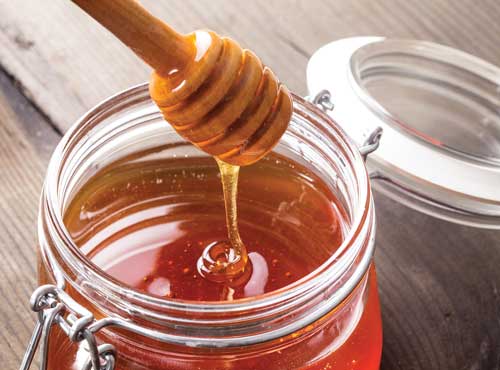Year of the pulse; How sustainability shapes purchase decisions
NEWS
 Steeping temperature, time affect antioxidants in tea
Steeping temperature, time affect antioxidants in tea
The temperature and length of time tea leaves are steeped affects their antioxidant properties, according to a recent Journal of Food Science study. The effects also differ across types of tea.
In the study, researchers tested six types of tea leaves that showed high levels of antioxidant capacity and activity. The most effective steeping temperature and time was dependent on the type of tea. The highest activity for white tea was in prolonged hot water and in some assays prolonged hot and cold extracts, and green tea showed the highest activity during prolonged cold steeping. Black tea showed the most antioxidant activity in a short hot water infusion. In addition, the overall antioxidant capacity of white and green tea was found to be greater than that of black tea.
The authors conclude that this information can be used to develop a standard and integrated method of preparing different types of tea infusions to maximize their potential health benefits.
2016 is the year of the pulse
The United Nations declared 2016 the International Year of Pulses, a campaign that is intended to highlight the role of pulses such as lentils, beans, and peas in addressing world health and nutrition, according to Jessie Hunter, director of domestic marketing for the USA Dry Pea & Lentil Council.
“In the U.S., pulse crops play a role in increasing food security because they are an affordable food that is very shelf-stable,” says Hunter. “Therefore individuals and families can purchase lentils, chickpeas, dry peas, or dry beans for a reasonable price and store them in the pantry or cabinet until they are ready to use them. This reduces food waste as well, which is a significant issue in food security.”
In addition, Hunter has seen an increase in pulse ingredients being incorporated into food products because of their water-binding and emulsification properties and their ability to add fiber, protein, minerals, and vitamins to foods. She also notes that they provide clean label opportunities, as they are not genetically modified and are not one of the top eight allergens.
Natsuki Fujiwara, food scientist at Northern Crops Institute, sees pulse flours as a good start for manufacturers who want to introduce pulse ingredients into their products and cites Barilla Protein Plus pasta as an example of a retail product taking this approach. Pulse flours can also replace wheat flours in gluten-free pastas, such as in red lentil pasta.
Fujiwara hopes that manufacturers will think outside the pasta and soup box, though, when it comes to using pulses. “Pulses can be a healthy substitute for many cereal grains used in side dishes, entrées, and even dessert,” she says. “I like pureeing cooked pulses and using it as a thickening agent in my crockpot dishes.” She adds that pulses have a naturally high viscosity, making them useful as a thickening agent, and they can also improve browning and water absorption.
Throughout the year, the UN will sponsor a variety of events in the United States promoting this message, including the Global Product Development Showcase at IFT16 in July.
WHO estimates global burden of foodborne diseases
A report by the World Health Organization (WHO)—the first ever to look at global estimates of foodborne diseases—examined the effects of 31 agents that spread foodborne disease, including bacteria, viruses, parasites, toxins, and chemicals, and found that 600 million people—about 10% of the global population—will become ill after eating contaminated food annually. About 420,000 of these individuals die, including 125,000 children under 5 years old.
The food industry can play an important role in preventing the spread of these pathogens, according to Kazuaki Miyagishima, director of the Dept. of Food Safety and Zoonoses for the WHO. “The industry’s contribution [to food safety] is huge,” he says, pointing to process-based controls like HACCP as necessary tools for stopping contamination before it can spread, whether into processed foods or as exports.
He also emphasizes the importance of transparency within the food industry, particularly in controlling outbreaks when they do occur. He calls on countries, public health authorities, and food operators to share and exchange information to enable speedy recalls. “If you withhold the information for another week,” he says, “in one week the food may be handed over to the third- or fourth-level food handlers or processors and the impact and complexity for the food recall will grow exponentially.”
Miyagishima points to whole genome sequencing as a promising tool for tracing which pathogen contaminated a certain food; this technique was previously expensive, but the costs have come down significantly over the last 10 years, he says.
“The provision of safe, nutritious, and acceptable food is really the heart of poverty reduction, food security, and everything: it doesn’t make sense to have food in abundance that is not safe for consumption,” says Miyagishima. “Food security is a big deal, but food safety is an essential component in it.”
--- PAGE BREAK ---
Sustainability shaping purchasing decisions
An increasing focus on sustainability has shaped the way today’s grocery shopper makes purchasing decisions, according to a new report from Nielsen. The Sustainability Imperative Report finds that 66% of consumers are willing to pay more for sustainable brands, a 16% increase from two years ago, and 45% of consumers said a company’s commitment to the environment swayed their decision to buy a product.
According to Linda Gilbert, founder and CEO of EcoFocus Worldwide, manufacturers need to ensure that they are providing trustworthy, eco-friendly choices for consumers that embody the company’s mission and aren’t simply marketing ploys.
“Manufacturers have tremendous opportunities for innovation by identifying real solutions to sustainability challenges, versus paying [lip] service to the easy answers,” she says. “For many consumers, the greatest hurdles to making eco-friendly choices are availability, affordability, and practicality. They want to make responsible choices and believe eco-friendly choices are desirable.” In addition, manufacturers can also use their packaging to share their story and better illustrate the connection between sustainability benefits and personal health benefits, Gilbert says.
Gilbert points to Organic Valley as creating the “gold standard” of products that “share consumer values by offering purity, clean products, a commitment to small and family farms, cooperative marketing, use of paper packaging, and creating an environment on package to tell their story.”
On the ingredients side, certified ingredients—such as USDA Organic, non-GMO, and Fair Trade—are gaining ground with consumers who are trying to sort through a crowded marketplace to find eco-friendly choices. Gilbert cites palm oil as one example: although it is a desirable alterative to partially hydrogenated oils, its production practices are controversial. To lend confidence to the palm oil produced there, Malaysia is establishing a certification for sustainable palm oil. “These aims match with many of the attitudes of U.S. grocery shoppers,” Gilbert says.
 How minerals, heavy metals affect honey
How minerals, heavy metals affect honey
A paper published in Comprehensive Reviews in Food Science and Food Safety reviews the physicochemical properties of honeys found around the world.
Honey consists of organic and inorganic constituents, and its chemical composition can be determined through several analytical methods, including spectroscopy. The paper, “Physicochemical Properties, Minerals, Trace Elements, and Heavy Metals in Honey of Different Origins: A Comprehensive Review,” examines how the concentration of minerals, trace elements, and heavy metals differ in honeys found around the world, meaning that the composition of these elements can be used to determine its geographical and botanical sources. It also discusses how an increased concentration of certain compounds in honey can be used as a bioindicator of environmental pollution.
• Costco became the first food retailer to commit to sourcing cage-free eggs, and it expects to sell more than one billion cage-free eggs in 2016.
• DuPont and The Dow Chemical Co. entered a definitive agreement to merge. The combined company will be named DowDuPont.
• Frutarom acquired 100% of the share capital of the Hong Kong–based companies Inventive Technology and Prowin International.
• Golden Peanut and Tree Nuts, a subsidiary of Archer Daniels Midland Co., acquired an 80% ownership stake in a peanut shelling and storage facility in Jan Kempdorp, South Africa.
• Healthy Food Ingredients acquired Suntava Corp., which will operate as a division of Healthy Foods Ingredients under the Suntava name.
• International Flavors & Fragrances launched a new branding initiative, including a new website, purpose statement, visual identity, and tone.
• JAB Holding Co. led an investor-group buyout of Keurig Green Mountain, known for its K-Cup single-serve coffee pods.
• MGP received the Circle of Champions Award, which recognizes gender diversity on its board of directors, from Central Exchange of Kansas City.
• Purdue University College of Agriculture and Purdue Research Foundation announced the creation of a $2 million fund to help launch startups based on Purdue plant sciences innovations focused on advancing crop traits and generating higher yields.
• Ready Pac Foods announced that it has expanded its internship program to Arizona State University beginning this year.
• Scientists at the University of California, Davis, sequenced the genome of the Chandler walnut variety, the first reference genome sequence for a nut crop.
• Scientists including John W. Erdman Jr. and Mary Ann Lila were part of a research team that traced the human metabolism of lycopene.
 Melanie Zanoza Bartelme, Associate Editor
Melanie Zanoza Bartelme, Associate Editor
[email protected]
